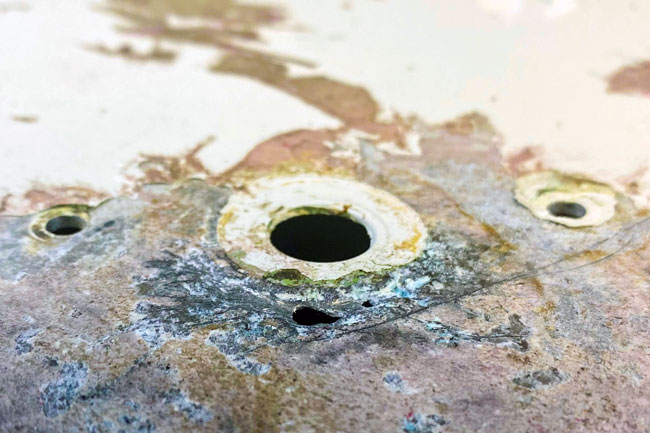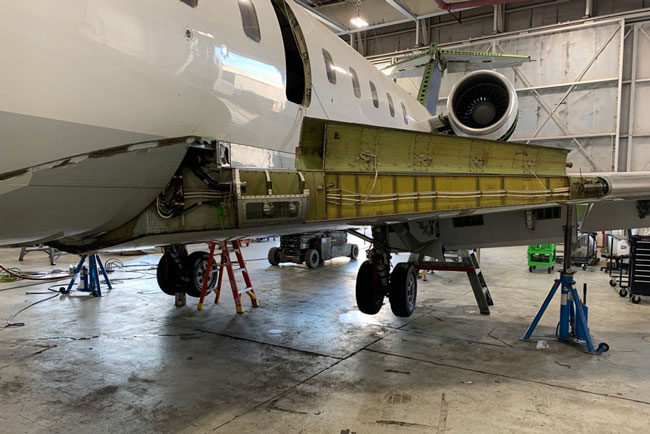In today's world of frequent air travel, the upkeep and maintenance of aircraft present many technical challenges. All metal surfaces deal with the threat of corrosion, a problem that can come from their environment, storage, cleaning, and climate, among other factors.

The aluminum from which airplanes are constructed will degrade over the course of the corrosion process. First, this can be seen as a dulling of the aluminum surface, then pitting of the metal, and finally, severe damage. If left untreated, it can render the aircraft unusable within a few years. However, there are many options today to prevent this corrosive process, including pretreatment, primers, and paints.
This guide will offer you an overview of corrosion prevention solutions as a critical aspect of aviation operations. Our focus here is on the type of preventative options that get applied during or immediately after manufacturing. We will outline the most common pretreatments, primers, and paints, emphasizing the importance of each, with our aim being to give the knowledge necessary to determine which corrosion prevention solution is best for you.
In order to understand which corrosion prevention solution you need, it is important to discuss the most notable contributing causes. The specific susceptibility of an aircraft can be quantified by the following phases of corrosion prevention:
The most effective way to deter corrosion is to implement a specific prevention plan combining the most suitable pretreatments, primers, and paints while taking into account the above variables. Ideal corrosion solutions optimize affordability and mitigate exposure to hazardous materials. In addition to acting as sealants, products like pretreatments, primers, and paints further combat corrosion by resisting condensation, regulating temperature, and increasing adhesive strength.
The first step in any corrosion solution is perhaps the most imperative: preventing the problem before it begins with the use of a pretreatment method. For aircraft, this involves depositing a substrate onto the aluminum surface prior to priming and painting. Two options for this phase are anodization and chemical conversion coating. Both serve the same purpose, and are highly effective and economical.
Anodizing is accomplished through an electrochemical reaction that forms a stiff film over the surface of the aluminum. There are many different types available. Some of the most common anodizing agents are listed below:

In order to complete the anodizing process, the surface is first washed with hot water and soap, then electrolytically treated through the application of acid and water. Once this occurs, an oxide film is formed and the part is washed once more. As the aluminum oxide film hardens, a protective layer emerges which prevents corrosion by masking the surface from exposure to the elements.
Chemical conversion coating functions similarly to anodizing, though it utilizes a more complex chemical process. As the name implies, the coating converts the original metal into a film composed of non-metallic chromatin. Application follows the same steps as anodization. The most common treatments are:
In addition to corrosion prevention, these pretreatments have a wide variety of benefits, including extending the lifespan of aircraft, increasing paint and primer adhesion, and even improving the aesthetics.
In the corrosion prevention process for aircraft, pretreatment is followed by the sealant phases, in which aircraft parts will receive primer and a paint topcoat. First, the primer is applied. The primary functions of primers are:
For many years, zinc chromate has been the primer of choice due to its effectiveness and affordability. As an inhibitor, it creates a diffusive barrier allowing for an exchange of water and chromate ions. The resulting ionization in turn deters corrosion through the prevention of electrolytic exchange within the sealants and the metal surface. With the changing of environmental regulations, new non-chromated primer technologies are currently in development.
Primer is easy to apply in a thin coat. After pretreatment has been completed, the aircraft part must receive a meticulous cleaning before primer is applied.

The final step in corrosion control is the application of the paint topcoat. Its functions include:
This surface finish is typically composed of an organic solution which is thinned and applied in several even coats to a thickness of a few mils. Some aircraft that fly in particularly humid coastal climates require more specialized coatings to deal with increased exposure.
Pretreatment, primers, and paints provide important preventative barriers against corrosion. Now that you understand the importance of each phase, you will be able to properly select methods to combat corrosion for your aircraft. Get in touch with an Av-DEC representative to find out which primers, sealants, and corrosion prevention products will fit your aircraft's needs.